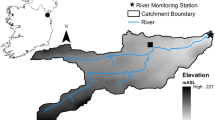Abstract
Advances in process-based modelling of loads of nitrogen and phosphorus carried by rivers have created new possibilities to interpret time series of water quality data. We examined how model runs with constant anthropogenic forcing can be used to estimate and filter out weather-driven variation in observational data and, thereby, draw attention to other features of such data. An assessment of measured and modelled nutrient concentrations at the outlets of 45 Swedish rivers provided promising results for total nitrogen. In particular, joint analyses of observational data and outputs from the catchment model S-HYPE strengthened the evidence that downward trends in nitrogen were due to mitigation measures in agriculture. Evaluation of modelled and observed total phosphorus concentrations revealed considerable bias in the collection or chemical analysis of water samples and also identified weaknesses in the model outputs. Together, our results highlight the need for more efficient two-way communication between environmental modelling and monitoring.











Similar content being viewed by others
References
Arheimer, B., Dahné, J., Donnelly, C., Lindström, G., & Strömqvist, J. (2011a). Water and nutrient simulations using the HYPE model for Sweden vs. the Baltic Sea basin—influence of input-data quality and scale. Hydrology Research, 43, 315–329.
Arheimer, B., Dahné, J., Lindström, G., Marklund, L., & Strömqvist, J. (2011b). Multi-variable evaluation of an integrated model system covering Sweden (S-HYPE). IAHS Publications, 345, 145–150.
Arnold, J. G., Moriasi, D. N., Gassman, P. W., Abbaspour, K. C., White, M. J., Srinivasan, R., et al. (2012). SWAT: model use, calibration, and validation. Transactions of the ASABE, 55, 1491–1508.
Behrendt, H., Bach, M., Kunkel, R., Opitz, D., Pagenkopf, W-G., Scholz, G., & Wendland, F. (2003). Nutrient emissions into river basins of Germany on the basis of a harmonized procedure. Federal Environmental Agency Report 82/2003, UBA-FB 000446, Berlin, Germany.
Clement, L., Thas, O., Ottoy, J. P., & Vandrolleghem, P. (2007). Data management of river water quality data: a semi-automatic procedure for data validation. Water Resources Research, 43(8).
Donnelly, C., Dahné, J., Rosberg, J., Strömqvist, J., Yang, W., & Arheimer, B. (2010). High-resolution, large-scale hydrological modelling tools for Europe. IAHS Publications, 340, 553–561.
Fölster, J., Kyllmar, K., Wallin, M., & Hellgren, S. (2012). Kväve- och fosfortrender i jordbruksvattendrag. Har åtgärderna gett effekt? Rapport 2012:1 (in Swedish). Department of Aquatic Sciences and Assessment, Swedish University of Agricultural Sciences (SLU), Ultuna, Sweden.
HELCOM (1992). The 1992 Convention. http://www.helcom.fi/Convention/. Accessed 26 Aug 2013.
HELCOM (2007). HELCOM Ministerial Meeting 2007. http://www.helcom.fi/BSAP/MinisterialMeeting/. Accessed 26 Aug 2013.
HELCOM (2011). Fifth Baltic Sea Load Compilation (PLC-5). Baltic Sea Environment Proceedings No. 128.
Hussian, M., Grimvall, A., & Petersen, W. (2004). Estimation of the human impact on nutrient loads carried by the Elbe River. Environmental Monitoring and Assessment, 96, 15–33.
Kronvang, B., Behrendt, H., Andersen, H. E., Arheimer, B., Barr, A., Borgvang, S. A., et al. (2009). Ensemble modelling of nutrient loads and nutrient load partitioning in 17 European catchments. Journal of Environmental Monitoring, 11, 572–583.
Libiseller, C., & Grimvall, A. (2002). Performance of partial Mann–Kendall tests for trend detection in the presence of covariates. Environmetrics, 13, 71–84.
Lindström, G., Pers, C. P., Rosberg, R., Strömqvist, J., & Arheimer, B. (2010). Development and test of the HYPE (Hydrological Predictions for the Environment) model—a water quality model for different spatial scales. Hydrology Research, 41, 295–319.
Santhi, C., Srinivasan, R., Arnold, J. G., & Williams, J. R. (2006). A modeling approach to evaluate the impacts of water quality management plans implemented in a watershed in Texas. Environmental Modelling & Software, 21, 1141–1157.
Silgram, M., Schoumans, O. F., Walvoort, D. J. J., Anthony, S. G., Groenendijk, P., Strömqvist, J., et al. (2009). Subannual models for catchment management: evaluating model performance on three European catchments. Journal of Environmental Monitoring, 11, 526–539.
Sirisack, S., & Grimvall, A. (2011). Visual detection of change points and trends using animated bubble charts. In: Ekundayo, E.O. (Ed.) Environmental Monitoring, InTech, November 11, 2011.
Stålnacke, P., & Grimvall, A. (2001). Semiparametric approaches to flow-normalisation and source apportionment of substance transport in rivers. Environmetrics, 12, 233–250.
Strömqvist, J., Arheimer, B., Dahné, J., Donnelly, C., & Lindström, G. (2012). Water and nutrient predictions in ungauged basins: set-up and evaluation of a model at the national scale. Hydrological Sciences Journal, 57, 229–247.
Wade, A. J., Durand, P., Beaujouan, V., Wessel, W. W., Raat, K. J., Whitehead, P. G., et al. (2002). A nitrogen model for European catchments: INCA, new model structure and equations. Hydrology and Earth System Sciences, 6, 559–582.
Wahlin, K., & Grimvall, A. (2008). Uncertainty in water quality data and its implications for trend detection: lessons from Swedish environmental data. Environmental Science and Policy, 11, 115–124.
Wahlin, K., & Grimvall, A. (2010). Roadmap for assessing regional trends in groundwater quality. Environmental Monitoring and Assessment, 65, 217–231.
Author information
Authors and Affiliations
Corresponding author
Additional information
Highlights
• A catchment model of nitrogen and phosphorus is used to give added value to monitoring data.
• Model runs with fixed anthropogenic forcing single out weather-driven fluctuations.
• Analysis of weather-normalized observational data reveals trends and change points.
Rights and permissions
About this article
Cite this article
Grimvall, A., von Brömssen, C. & Lindström, G. Using process-based models to filter out natural variability in observed concentrations of nitrogen and phosphorus in river water. Environ Monit Assess 186, 5135–5152 (2014). https://doi.org/10.1007/s10661-014-3765-y
Received:
Accepted:
Published:
Issue Date:
DOI: https://doi.org/10.1007/s10661-014-3765-y




